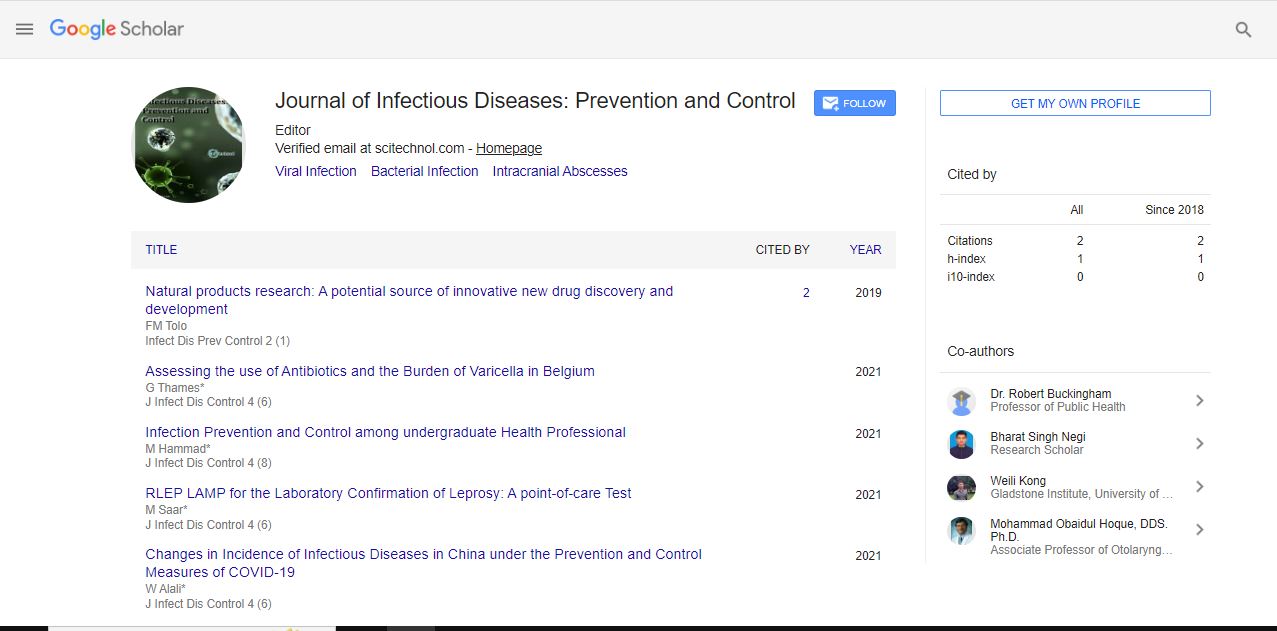Opinion Article, Infect Dis Prev Control Vol: 6 Issue: 4
The Dynamics of Clinical and Subclinical Infection Epidemiology
Hostetter Arzt*
1Department of Microbiology and Mycology, University of Chile, Santiago, Chile
*Corresponding Author: Hostetter Arzt,
Department of Microbiology and Mycology, University of Chile, Santiago, Chile
E-mail: hostarz@med.uchile.cl
Received date: 24 November, 2023, Manuscript No. IDPC-24-127264;
Editor assigned date: 27 November, 2023, Pre QC No. IDPC-24-127264 (PQ);
Reviewed date: 11 December, 2023, QC No. IDPC-24-127264;
Revised date: 18 December, 2023, Manuscript No. IDPC-24-127264 (R);
Published date: 26 December, 2023, DOI: 10.36648/idpc.6.4.152
Citation: Arzt H (2023) The Dynamics of Clinical and Subclinical Infection Epidemiology. Infect Dis Prev Control 6:4.
Description
In the field of infectious diseases, the connection between clinical and subclinical infections forms the environment of epidemiology. While clinical infections manifest with recognizable symptoms, subclinical infections operate stealthily, often evading detection. Clinical infections are characterized by overt symptoms that prompt individuals to seek medical attention. Fever, cough and other visible signs often accompany clinical infections, making them easily identifiable. In contrast, subclinical infections lack noticeable symptoms, with individuals carrying the pathogens without displaying overt signs of illness. Understanding the distinction between these two states is important for comprehending the complexities of infection dynamics.
Clinical infections typically play a central role in epidemiological studies due to their visibility and the ease of diagnosis. Surveillance systems often rely on reported cases of clinical infections to track the prevalence of diseases within populations. This data is important for predicting outbreaks, allocating resources and implementing public health measures. The spread of clinical infections is influenced by various factors, including host susceptibility, environmental conditions and pathogen characteristics. Rapid identification and isolation of individuals with clinical symptoms are key strategies to control the transmission of these infections within communities.
Subclinical infections, by their covert nature, present unique challenges in epidemiological surveillance. Individuals with subclinical infections may unknowingly spread pathogens to others, enabling to the solitude transmission of diseases. This stealthy propagation complicates efforts to control outbreaks, as carriers of subclinical infections may escape detection and continue to interact with the community. Recent advancements in diagnostic technologies have improved the ability to identify subclinical infections. Molecular tests and serological assays enable the detection of pathogens even in the absence of symptoms, shedding light on the true prevalence of subclinical infections within populations.
The relationship between clinical and subclinical infections is complex and bidirectional. Subclinical infections can serve as reservoirs for pathogens, maintaining the circulation of microbes within a population. Moreover, individuals who recover from clinical infections may transition into a subclinical state, becoming carriers without symptoms. Understanding this connection is important for effective disease control strategies. Immunization campaigns, for instance, not only aim to prevent clinical illness but also to reduce subclinical infections and interrupt the transmission chain. Comprehensive vaccination programs contribute not only to individual protection but also to community-wide immunity.
Epidemiologists face several challenges in accurately capturing the dynamics of clinical and subclinical infections. Limited access to diagnostic tools, underreporting of mild cases and the variability of immune responses complicate efforts to quantify the true burden of subclinical infections. Overcoming these challenges requires a multidisciplinary approach, integrating clinical, laboratory and population-based data.
Conclusion
Advancements in epidemiological analysis, combined with improved diagnostic capabilities, provide new avenues for understanding and managing clinical and subclinical infections. Integrating real-time data, genomic analysis and modeling techniques can enhance the ability to predict, prevent and respond to infectious disease threats. The dynamics of clinical and subclinical infection epidemiology emphasize the necessity of a comprehensive strategy to infectious disease management. By unraveling the complexities of these two states, analysts and public health professionals can develop strategies that address both visible and hidden aspects of infections.
 Spanish
Spanish  Chinese
Chinese  Russian
Russian  German
German  French
French  Japanese
Japanese  Portuguese
Portuguese  Hindi
Hindi 